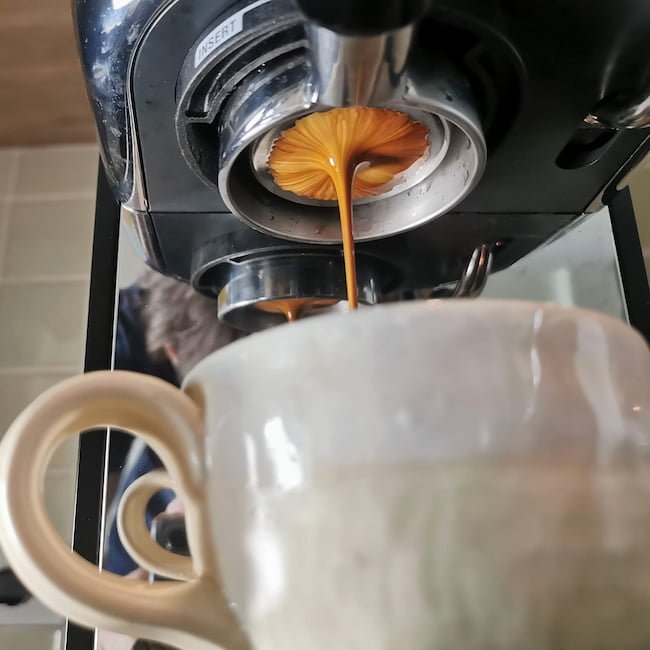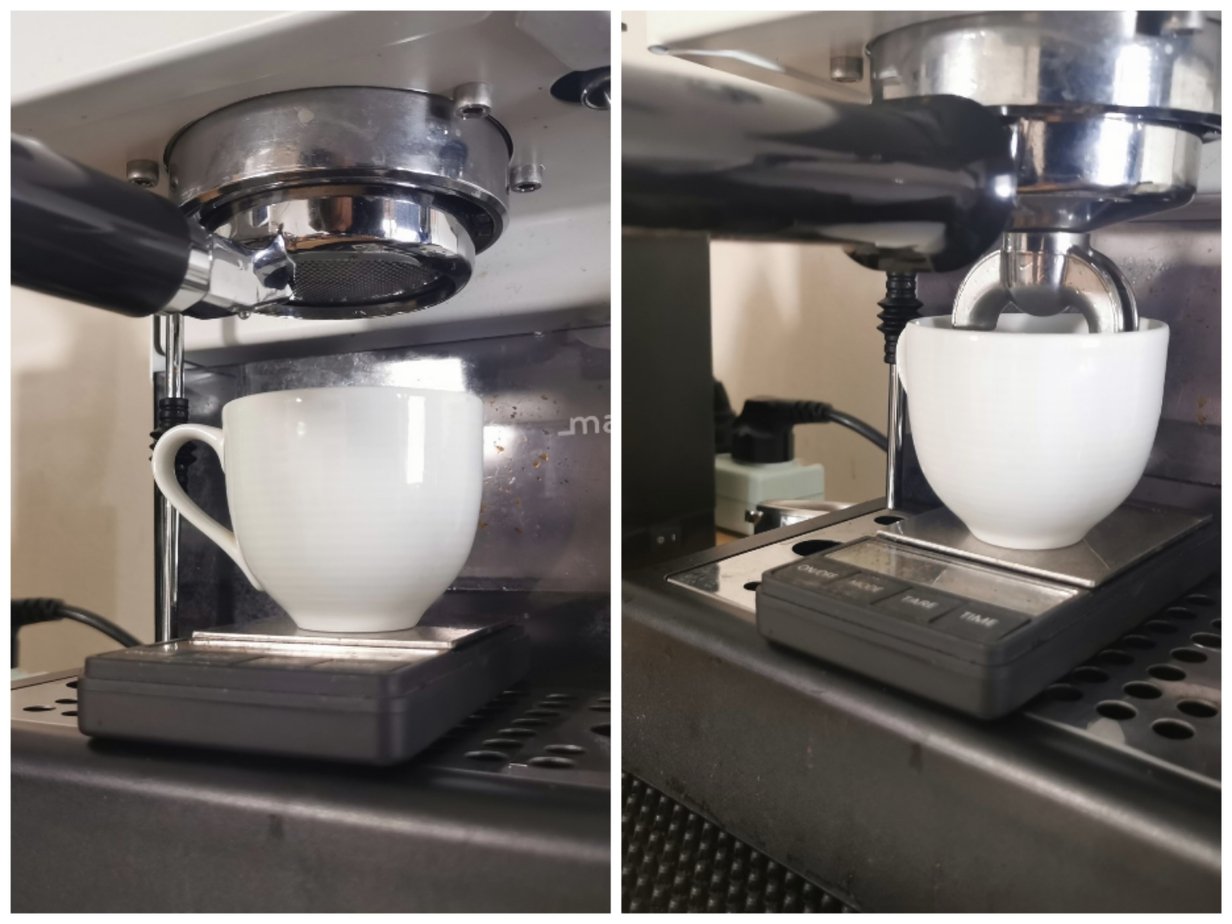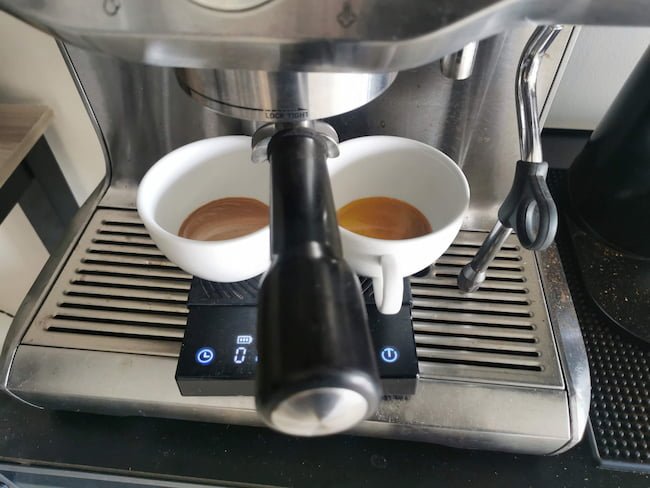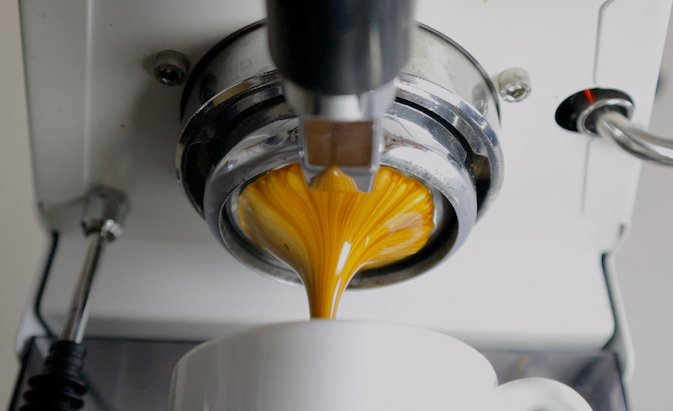You just bought an espresso machine, and now all the cool coffee bros on various forums talk about so-called “naked” portafilters.
You’re confused.
Why isn’t the regular portafilter that came with the big box good enough? 😕
Well, in this article, I’ll explain it in plain English.
Your espresso will NOT be inherently better by investing in a bottomless portafilter. But there are some positive side-effects that are worth it.
There are basically three different categories of benefits when it comes to switching from your regular, spouted portafilter to a bottomless one:
- Educational reasons
- Practical reasons
- Aesthetic reasons
In this article, I’ll break down all of the reasons for you. I’ll also explain why I think a bottomless model is such an excellent investment for most home-baristas.
The superficial reason
Let me start by explaining the most superficial yet convincing reason to get a bottomless portafilter: It looks incredible!
I have to admit that the visual aspect is often enough to justify the cost of many espresso accessories. And among the naked portafilter is probably #1.
How many social media posts have been created just to show a flawless naked extraction? I don’t even dare to guess, but we’re probably close to avo-smash level.

The real reason to get a bottomless portafilter
Now, let’s talk about the real reason that you should upgrade your filter holder.
A naked portafilter will give you a direct view of the filter basket. It’s for this reason, it’s educational.
The regular portafilter that comes with most espresso machines has an obstructed view, so you don’t really know how well the extraction process is going.
You might be able to guess a little bit from the flow rate of the liquid dripping out from the spout, but compared to a full view of the basket, you’re not learning much.
Some of the most important aspects of espresso are tamping and distribution. If you do a good job here, you’ll be able to get an even extraction.
This means that all parts of the puck are contributing evenly to the coffee. However, what often happens is that the puck will be extracted unevenly. There are several symptoms to be aware of here:
| Channeling | The water will favor some channels and run through faster |
| Dry pockets | Some parts of the puck remain dry through the shot |
| Donut preinfusion | This is also called side-channeling. Easy to diagnose with a naked basket. The extraction begins in a round circle; like a donut. |
| Separated streams | The espresso never meets in the middle. Poor puck prep. |
| Spraying | This is likely due to a very tiny channel combined with a high pressure at the group head. |
All these things can potentially lead to a poor extraction, manifesting in bitter, dry or hollow-tasting espresso.
All of these things are relatively easy to diagnose with a naked PF.
Next time you’re about to prepare your dose, you’ll know that you need to improve something. With experience, you’ll get a better and better understanding of what you need to fix.
This visual feedback is also indispensable if you want to test different tools or approaches to tamping and distribution.
Let’s say you’re testing a new tamper. Or the effect of an Aeropress filter on top of the puck. Well, with a naked basket, you can get direct visual feedback on your work.

Regular PORTAFILTER vs Bottomless
There are also some good practical reasons to go bottomless.
- Cleaning: It suddenly becomes much easier. In a regular portafilter, a lot of oils will get stuck underneath the filter basket and above the spout. This requires dedicated cleaning. You will have to remove the basket, which is more difficult on a regular portafilter.
On a naked portafilter, almost no oils will be left after you’ve knocked out the used puck. And if you really need to take out the basket, it’s super easy and convenient since you can just give it a little push from the backside, and it will come out immediately.
- Filter Basket sizes: With a regular portafilter, you have a constraint in the basket size you can use. This means that sometimes you won’t be able to squeeze in even a big double-shot basket. And if you want a triple-shot basket for those huge lattes, then forget about it.
- Clearance for a scale or big mug: Some espresso machines have a compact area between the group head and drip tray. By using a naked portafilter, you’ll have some extra space for your scale or mug. This is very welcome, especially on the Gaggia Classic Pro!
⚠️ Buy the right one!
It can be a little bit tricky to buy the right naked portafilter. For instance, it’s not enough that the size is correct.
Even though the size and locking lugs look identical to the stock portafilter on the surface, you might not get a tight seal.
Just a few milimeters on width of the locking lugs/fins can be enough to cause issues. For that reason you should pay close attention when ordering one.
Here, I have listed the correct portafilters for a range of the most popular espresso machines:
- Delonghi 51 mm Naked PF (Dedica)
- Gaggia Classic Pro bottomless Filter Holder
- Breville 54 mm: Barista Express, Bambino Plus, Duo Temp Pro, Infuser, Barista Pro, Barista Touch
- Breville 58 mm: Dual Boiler, Oracle, BES920XL, BES980XL
- Rancilio Silvia 58 mm bottomless portafilter
- E61 Portafilter (for most E61 machines, including Rocket, Expobar, ECM, Quick Mill, etc.)
- E61 Filter holder (Only for Faema)
What are the downsides?
There are only a few downsides to using a naked basket. Unfortunately, this is why they aren’t that suitable for commercial use but are better left for home users.
They are messy!
The first problem is that it can occasionally cause a mess. Especially if your grind size is way off.
Random spraying can mess up the counter, machine, or espresso cup. This is not something you want to deal with in the middle of a busy shift as a barista.
However, if you’re reasonably dialed in grind-wise, and your distribution and tamping is decent, you shouldn’t face any issues.

If you’re on the way to work in the morning, you might not want to deal with any cleaning.
In that case, just use your regular portafilter (which comes with all machines), and experiment with getting the extraction process right later.
Remember that you can take the lessons you learn from the naked portafilter and transfer them to the regular one. A shot from a regular portafilter won’t taste any worse, you just won’t get any feedback on potential issues.
Splitting is more difficult
Portafilters with two spouts are, of course, also a bit more suited for splitting a shot. So if you’re going to make two small cappuccini (and you don’t have an espresso shot glass with a spout), then, by all means, go ahead and use a standard double-spout portafilter.
